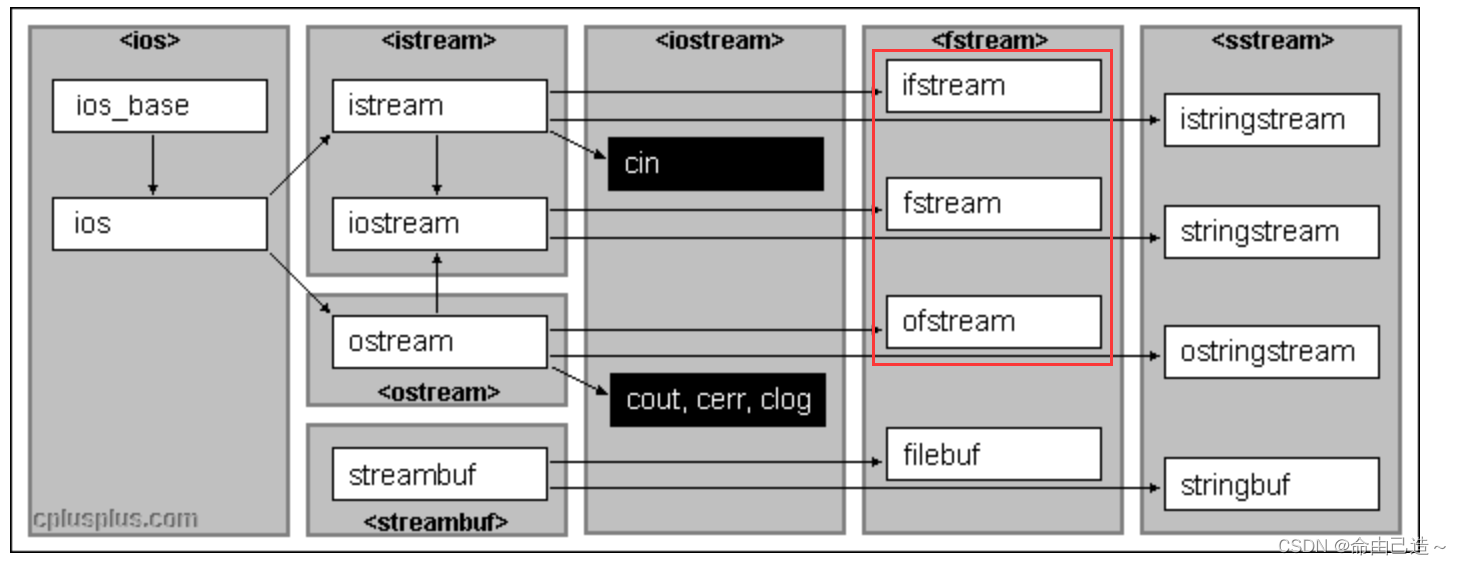<em>Mac</em>Book项目 2009年学校开始实施<em>Mac</em>Book项目,所有师生配备一本<em>Mac</em>Book,并同步更新了校园无线网络。学校每周进行电脑技术更新,每月发送技术支持资料,极大改变了教学及学习方式。因此2011
2021-06-01 09:32:01
int main()
{
string str;
while (cin >> str)
{
cout << str << endl;
}
return 0;
}

我們在OJ的時候經常會用到while(cin >> str),這裡的流提取實際上是個阻塞操作,只要緩衝區還有資料就繼續讀,預設以空格或者換行結束,有空格說明是把兩段字串尾插到str。
那麼它是怎麼結束呢?
答案是輸入[Ctrl]-c或者[Ctrl]-z + 換行。
[Ctrl]-c是傳送訊號結束程序。
[Ctrl]-z + 換行是通過返回值條件判斷結束while迴圈,具體看下面講解。
cin >> str的返回值是一個istream類

實際上返回的就是cin物件。而c++98支援了隱式型別轉換,把istream轉換為bool,所以能夠條件判斷。
具體是怎麼轉換的呢?
看下面這個例子:
class A
{
public:
A(int a)
: _a(a)
{}
private:
int _a;
};
int main()
{
// 內建型別轉換成自定義型別
A a = 1;
return 0;
}
這裡按道理來說是構造一個臨時物件再拷貝構造,而編譯器優化成了直接構造。如果沒有單引數的建構函式就無法轉換。
那如果我們想要讓自定義型別轉換成內建型別呢?
直接int aa = a;肯定會報錯。
但是我們可以加一個特殊的過載函數。
class A
{
public:
A(int a)
: _a(a)
{}
operator int()
{
return _a;
}
private:
int _a;
};
int main()
{
// 內建型別轉換成自定義型別
A a = 1;
// 自定義型別轉化成內建型別
int aa = a;
cout << aa << endl;
return 0;
}
而我們上面說的把istream轉化成bool型別就是類似這樣實現的。
operator bool() 裡面會檢查是特殊字元([Ctrl]-z )就會返回false。
我們知道cin和scanf都有自己的緩衝區,而如果我們用scanf寫入再用cout輸出,就會導致速度變慢很多(緩衝區拷貝)。
而sync_with_stdio函數是一個“是否相容stdio”的開關,C++為了相容C,保證程式在使用了std::printf和std::cout的時候不發生混亂,將輸出流綁到了一起。
決定C++標準streams(cin,cout,cerr…)是否與相應的C標準程式庫檔案(stdin,stdout,stderr)同步,也就是是否使用相同的stream緩衝區,預設情況是同步的,但由於同步會帶來某些不必要的負擔,因此該函數作用就是我們自己可以取消同步 。
#include <iostream>
int main()
{
std::ios::sync_with_stdio(false);
std::cin.tie(0);
// IO
}
檔案的讀寫有兩種:
1️⃣ 二進位制讀寫
2️⃣ 文字讀寫

ofstream是寫入檔案,而ifstream是從檔案中讀取。


這裡的參數列示我們想以什麼樣的方式開啟檔案。
比方說當我們想用二進位制的方式開啟檔案:
ofs.open ("test.txt", std::ofstream::out | std::ofstream::binary)
而我們也可以在構造的時候直接傳進引數。

ofstream ofs("test.txt", std::ios_base::out | std::ios_base::binary)
struct ServerInfo
{
char _address[32];
int _port;
};
struct Config
{
public:
Config(const char* filename)
: _filename(filename)
{}
void Write(ServerInfo info)
{
ofstream ofs("test.txt", std::ios_base::out | std::ios_base::binary);
ofs.write((char*)&info, sizeof info);
}
void Read(ServerInfo& info)
{
ifstream ifs("test.txt", std::ios_base::in | std::ios_base::binary);
ifs.read((char*)&info, sizeof info);
}
private:
string _filename;
};
int main()
{
Config con("text.txt");
ServerInfo si = { "aaaaaa", 910 };
con.Write(si);
return 0;
}

而我們也可以把資料讀回來。
int main()
{
Config con("text.txt");
//ServerInfo si = { "aaaaaa", 910 };
//con.Write(si);
ServerInfo si;
con.Read(si);
cout << si._address << " " << si._port << endl;
return 0;
}

可以看到記憶體中和寫出去顯示出來的不一樣。
當然我們可以用文字讀寫的方式。
struct ServerInfo
{
char _address[32];
int _port;
};
struct Config
{
public:
Config(const char* filename)
: _filename(filename)
{}
void Write(ServerInfo info)
{
ofstream ofs(_filename);
// 過載
ofs << info._address << endl;
ofs << info._port << endl;
}
void Read(ServerInfo& info)
{
ifstream ifs(_filename);
// 過載
ifs >> info._address;
ifs >> info._port;
}
private:
string _filename;
};
int main()
{
Config con("text.txt");
ServerInfo si = { "aaaaaa", 910 };
con.Write(si);
/*ServerInfo si;
con.Read(si);
cout << si._address << " " << si._port << endl;*/
return 0;
}



在程式中如果想要使用stringstream,必須要包含標頭檔案。在該標頭檔案下,標準庫三個類:
istringstream、ostringstream 和 stringstream,分別用來進行流的輸入、輸出和輸入輸出操作。
int main()
{
int a = 123;
const char* b = "456";
double c = 78.9;
ostringstream os;
os << a;
os << b;
os << c;
cout << os.str() << endl;
return 0;
}

當然我們也可以把每個資料都提取出來。但此時輸入的時候就要空格或者換行隔開。
int main()
{
int a = 123;
const char* b = "456";
double c = 78.9;
ostringstream os;
os << a << " ";
os << b << " ";
os << c << " ";
string ret = os.str();
cout << ret << endl;
int d;
char e[20];
double f;
istringstream is(ret);
is >> d >> e >> f;
cout << d << " ";
cout << e << " ";
cout << e << " ";
return 0;
}

序列化指的是將一個記憶體物件轉化成一串位元組資料(儲存在一個位元組陣列中),可用於儲存到本地檔案或網路傳輸。反序列化就是將位元組資料還原成記憶體物件。
序列化:將物件變成位元組流的形式傳出去。
反序列化:從位元組流恢復成原來的物件。
簡單來說,物件序列化通經常使用於兩個目的:
1️⃣ 將物件儲存於硬碟上,便於以後反序列化使用;
2️⃣ 在網路上傳送物件的位元組序列
我們現在模擬一個聊天的傳送視窗。
class Date
{
friend ostream& operator << (ostream& out, const Date& d);
friend istream& operator >> (istream& in, Date& d);
public:
Date(int year = 1, int month = 1, int day = 1)
:_year(year)
, _month(month)
, _day(day)
{}
private:
int _year;
int _month;
int _day;
};
istream& operator >> (istream& in, Date& d)
{
in >> d._year >> d._month >> d._day;
return in;
}
ostream& operator << (ostream& out, const Date& d)
{
out << d._year << " " << d._month << " " << d._day;
return out;
}
struct ServerInfo
{
friend istream& operator >> (istream& in, ServerInfo& si);
friend ostream& operator << (ostream& out, ServerInfo& si);
string _name;// 暱稱
Date _d;// 時間
string _msg;// 資訊
};
istream& operator >> (istream& in, ServerInfo& si)
{
in >> si._name >> si._d >> si._msg;
return in;
}
ostream& operator << (ostream& out, ServerInfo& si)
{
out << si._name << " ";
out << si._d << " ";
out << si._msg << " ";
return out;
}
int main()
{
ServerInfo p{ "海闊天空", {2023, 4, 19}, "hello" };
stringstream os;
os << p;
string ret = os.str();
ServerInfo is;
stringstream oss(ret);
oss >> is;
cout << "-------------------------------------------------------" << endl;
cout << "暱稱:" << is._name << " ";
cout << is._d << endl;
cout << is._name << ": " << is._msg << endl;
cout << "-------------------------------------------------------" << endl;
return 0;
}

到此這篇關於C++檔案IO流及stringstream流讀寫檔案和字串操作詳解的文章就介紹到這了,更多相關C++檔案IO流內容請搜尋it145.com以前的文章或繼續瀏覽下面的相關文章希望大家以後多多支援it145.com!
相關文章

<em>Mac</em>Book项目 2009年学校开始实施<em>Mac</em>Book项目,所有师生配备一本<em>Mac</em>Book,并同步更新了校园无线网络。学校每周进行电脑技术更新,每月发送技术支持资料,极大改变了教学及学习方式。因此2011
2021-06-01 09:32:01

综合看Anker超能充系列的性价比很高,并且与不仅和iPhone12/苹果<em>Mac</em>Book很配,而且适合多设备充电需求的日常使用或差旅场景,不管是安卓还是Switch同样也能用得上它,希望这次分享能给准备购入充电器的小伙伴们有所
2021-06-01 09:31:42

除了L4WUDU与吴亦凡已经多次共事,成为了明面上的厂牌成员,吴亦凡还曾带领20XXCLUB全队参加2020年的一场音乐节,这也是20XXCLUB首次全员合照,王嗣尧Turbo、陈彦希Regi、<em>Mac</em> Ova Seas、林渝植等人全部出场。然而让
2021-06-01 09:31:34

目前应用IPFS的机构:1 谷歌<em>浏览器</em>支持IPFS分布式协议 2 万维网 (历史档案博物馆)数据库 3 火狐<em>浏览器</em>支持 IPFS分布式协议 4 EOS 等数字货币数据存储 5 美国国会图书馆,历史资料永久保存在 IPFS 6 加
2021-06-01 09:31:24

开拓者的车机是兼容苹果和<em>安卓</em>,虽然我不怎么用,但确实兼顾了我家人的很多需求:副驾的门板还配有解锁开关,有的时候老婆开车,下车的时候偶尔会忘记解锁,我在副驾驶可以自己开门:第二排设计很好,不仅配置了一个很大的
2021-06-01 09:30:48

不仅是<em>安卓</em>手机,苹果手机的降价力度也是前所未有了,iPhone12也“跳水价”了,发布价是6799元,如今已经跌至5308元,降价幅度超过1400元,最新定价确认了。iPhone12是苹果首款5G手机,同时也是全球首款5nm芯片的智能机,它
2021-06-01 09:30:45